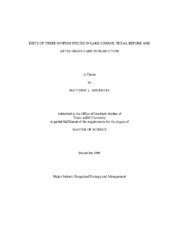| dc.description.abstract | Hydrilla (Hydrilla verticillata) is an invasive aquatic plant that grows quickly
across shallow freshwater habitats. It is a problem for recreational users of lakes and
landowners. Grass carp (Ctenopharynogodon idella) is an effective biological control
agent that preferentially consumes and can control the spread of hydrilla. However, grass
carp also will consume other vegetation, which influences aquatic communities via
direct and indirect interactions that can change food and habitat availability and use by
various species. Aquatic plants influence habitat and types of prey used by sunfish
(Centrarchidae), which must also avoid their own predators. Prey use among sunfish
species depends on density and taxonomic identity of both prey and vegetation. This
was a one-year analysis of stomach contents from three common species of
invertivorous sunfish: bluegill (Lepomis macrochirus), longear sunfish (Lepomis
megalotis), and redear sunfish (Lepomis microlophus). Thirteen sampling stations were
randomly selected using ArcGIS software. Percentage of water surface covered by
vegetation was recorded at each station. A five-minute electrofishing sample was
performed within the littoral zone early morning in late September. The stomach contents of all targeted sunfish (N=489) showed high percentages of diet overlap pre-
(0.77-0.92) and post- (0.83-0.88) introduction of grass carp. Multivariate analysis
showed total explained variation (15.5%) in sunfish diet composition was (P < 0.05)
correlated significantly with sunfish species (6.67%), percent surface vegetation
coverage (3.97%), and sampling periods pre- versus post-introduction of grass carp
(2.13%). Prey-specific abundance showed that all sunfishes displayed a generalized
feeding strategy in both sampling periods. Diets of each sunfish species showed
differences in abundance (by volume) and occurrence (among individual fish) of prey
items between sampling periods. Levin?s standardized index of diet breadth for all
sunfish species decreased from pre- (0.12) to post-introduction (0.05). Results imply that
vegetation control by grass carp influenced the diets and feeding strategies of three
cohabitating sunfish species. These findings may help fisheries biologists to plan future
management actions that influence assemblages of aquatic plants and
macroinvertebrates, herbivorous fish, invertivorous prey-fish, and piscivorous game fish,
to promote a healthy and balanced ecosystem for Lake Conroe stakeholders. | en |


